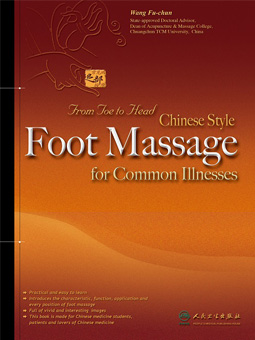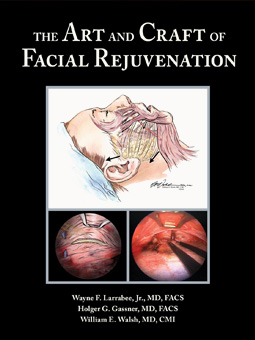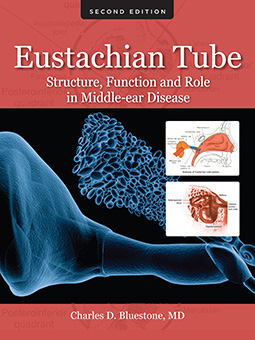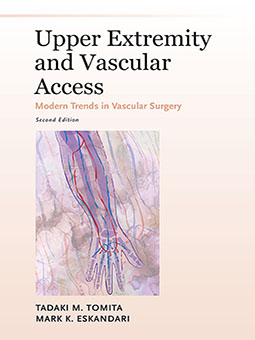
Upper Extremity and Vascular Access, a volume in the Modern Trends in Vascular Surgery series, covers a range of topics that pertain to hemodialysis access and the upper extremities. The book is divided into six sections: (1) history of the symposium; (2) the creation of hemodialysis access ranging from preoperative evaluation to new graft design and concluding with a chapter on dialysis access coding and billing; (3) the management of hemodialysis access complications with chapters that discuss difficult decision-making with complex patients; (4) issues related to upper extremity catheters in the venous and arterial systems; (5) upper extremity compression syndromes including thoracic outlet syndrome; (6) management of upper extremity trauma and both open surgical approaches and endovascular options.
The annual symposium on vascular surgery, sponsored by the Division of Vascular Surgery at the Northwestern University Feinberg School of Medicine, addresses contemporary topics and controversies in vascular and endovascular surgery. Presentations at the symposium cover the full spectrum of vascular surgery, including changes in management of extracranial cerebrovascular disease, new treatment options for lower extremity arterial occlusive disease, hemodialysis access, improvements in techniques for complex venous disease, and developments in aortic stent graft repair in the chest and abdomen. The Modern Trends in Vascular Surgery series is a topical compilation of the standout presentations from the most recent three symposia.
Lower Extremity Vascular Disorders (Arterial and Venous)
Complex Arterial and Venous Problems
Diseases of the Aorta
Carotid and Supra-Aortic Trunk Disorders
With over 794 illustrations, From Toe to Head: Chinese Style Foot Massage for Common Illnesses is a hands-on guide that addresses 33 common diseases that can be cured through foot massage. This book details 15 manipulation techniques, provides helpful advice for diet and exercise and takes you step-by-step through information rarely shown about foot massage. This is not just a way to learn more about an ancient practice, but a manual with practical methods for every day usage.
The authors of The Art and Craft of Facial Rejuvenation, have presented the essential techniques and procedures that constitute the heart of the specialty. Descriptions enable the experienced surgeon to accurately reproduce each technique, and answer the student’s key question: How do you really do it?
Detailed intraoperative photography, and drawings by medical illustrator Dr. William E. Walsh, illustrate each chapter. The images depict all important maneuvers and cover every important step of the operation for the best possible reproducibility of the surgery described.
Procedures proven to reliably generate excellent results were selected and described with the goal to provide a solid foundation for residents, fellows, and practicing surgeons with an interest in facial rejuvenation surgery.
The Art and Craft of Facial of Rejuvenation is also available in Paperback
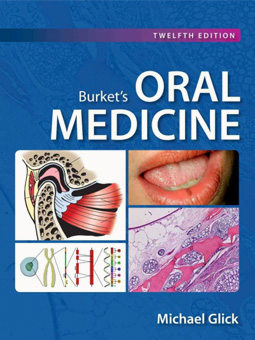
Inherently interdisciplinary, the field of oral medicine continues to incorporate and apply new knowledge and techniques to the care of patients. For nearly 70 years, Burket’s Oral Medicine has been the principal text for all major aspects of oral medicine, from the basic science to clinical practice. This 12th edition continues to serve as the authoritative source of information for students, residents, and clinicians interested in the field of oral medicine.
Through the addition of new chapters and substantial new material, the 12th edition of the book significantly advances the understanding of today’s practice of oral medicine. Research findings are produced at a rapid pace and are readily accessible from a variety of sources. A chapter on clinical research has been added to the book to help readers interpret how scientific findings reported in the literature impact their practice. Awareness of the unique aspects of oral health needs for the elderly, infants, and young children prompted the inclusion of two new chapters introducing the fields of geriatric and pediatric oral medicine. Two other original chapters on radiologic interpretations and complications of nonsurgical cancer therapy complement in more detail other broader topics addressed in the book.
The 12th edition of Burket’s Oral Medicine continues the tradition of this text in providing students, residents, and experienced practitioners with access to the expertise and experience of an international group of clinical scholars who are recognized experts in the increasingly complex field of diagnosis and medical management of maxillofacial disease and dental treatment of medically complex patients.
KEY FEATURES
Hundreds of color illustrations and figures enhance the text
Comprehensive coverage of geriatric and pediatric oral medicine
New chapters on clinical research, complications of cancer therapy, and interpretation of panoramic radiography
The full 111-page References can be downloaded here.
Practical Practice Solutions in Dentistry: Building Your Successful Future provides a broad overview of how to start a business and be successful. With contributions from industry experts sharing real-life lessons learned in the management of dentistry offices, this volume delivers a comprehensive practice management resource.
The editor, Dr. Sheri B. Doniger, sets a course to collect expert advice on basic and complex concepts for dentists starting out as small business owners. The chapter contributors provide readers with dental industry voices sharing information from a first-hand viewpoint. Chapters offer strategies for business topics such as negotiating leases, hiring and team training, and billing and dental coding.
Practical Practice Solutions in Dentistry: Building Your Successful Future will be useful for instruction, for use in seminars, and to dental students and practicing clinicians.
The Beta-Blocker Story: Getting it Right provides an essential guide for medical students and practitioners assessing patients for beta-blocker therapy. Using an evidence-based approach, the author, John Malcolm Cruickshank, provides readers with a thorough overview of beta-blocker use in the treatment of conditions such as ischemic heart disease, post-myocardial infarction, heart failure, dysrhythmias, and hypertension.
The Beta-Blocker Story: Getting it Right received a 100 score from Doody’s Review Service. See review below.

As one of today’s leading researchers of middle-ear disorders, Dr. Bluestone offers a unique perspective on the diagnosis and management of common middle-ear problems. Eustachian Tube: Structure, Function and Role in Middle-ear Disease is the first book to comprehensively cover these disorders in both adults and children.
Eustachian Tube begins with an overview of middle-ear anatomy and the epidemiology of middle ear disorders, then, progresses to discussion of current tests of eustachian tube function, as well as the physiology and pathophysiology of the eustachian tube.
Dr. Bluestone draws on his extensive clinical experience to describe the latest surgical and nonsurgical methods of middle-ear treatment. Throughout, photographs and drawings illustrate anatomy and pathophysiology.
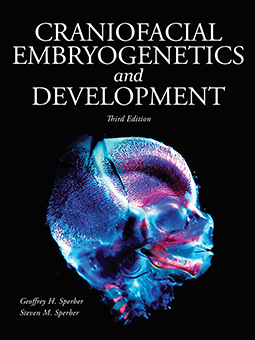
The field of embryology has experienced a period of explosive growth since the previous edition of this book was published nearly a decade ago. The insights of genetic expression in determining the unfolding of the embryonic layers have revolutionized our understanding of some of the mechanisms of embryogenesis.
As implied by the title of the third edition, Craniofacial Embryogenetics and Development, genetics is linked with embryology in this text. Virtually all embryological development has an underlying genetic component, and the basic science of genetics is the key in uncovering the many mysteries of embryogenesis. The tools of molecular genetics have provided insights into developmental mechanisms that allow us the ability to identify transient regions of genetic expression patterns.
Unraveling the precise biochemical and mechanical interactions of discrete regions in the unfolding embryonic components remains a dauntingly complex challenge to understanding the conversion of the genome into the phenome. The addition of genetic information gleaned from other mammalian species might aid in dissecting human embryology into comprehensible components to understand normal and abnormal development. The third edition of Craniofacial Embryogenetics and Development is dedicated to this objective.
Key Features:
- Provides clinicians with a basic background for assessing and treating craniofacial anomalies.
- Describes recent technical advances in optical projection tomography, photoacoustic and 3D imaging, small-angle X-ray scattered (SAXS) tomography and morphometrics and their impact on embryogenetics.
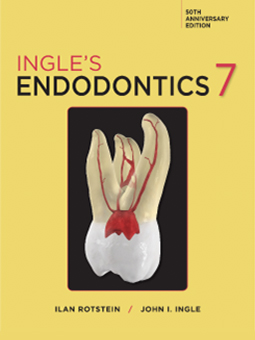
The seventh edition of Ingle’s Endodontics is the most recent revision of the text that has been known as the “Bible of Endodontics” for half a century. It continues the tradition of including an international group of authors, contributing new cutting-edge knowledge and updates on topics that have formed the core of this book for years and also contributing new chapters that reflect the ways in which the field has evolved over the 50 years since its inception.
It will continue to be the standard against which all other endodontic texts will be measured. The main divisions of the book in the new edition are The Science of Endodontics, The Practice of Endodontics, and Interdisciplinary Endodontics.
The 40 chapters are enhanced with color illustrations. New chapters in this edition include:
- Periradicular disease
- Dental innervations and pain of pulpal origin
- Cone beam computed tomography
- Magnetic resonance imaging
- Preparation for endodontic treatment
- Endodontic therapy in teeth with anatomical variations
- Achieving long-term success with endodontic therapy
- Management of teeth with immature apices
- Regenerative endodontics
- Intentional replantation of endodontically treated teeth
- Endodontic therapy in the elderly patient
- Endodontic therapy in the pediatric patient
In addition, many other chapters have been completely updated to reflect the most current concepts and techniques in endodontics. With contributions from the world’s experts in all phases of the specialty, Ingle’s Endodontics, 7th edition, promises to be the indispensible endodontic textbook, an essential part of every endodontist’s library.
We are pleased to be a sponsor of The John I. Ingle International Endodontic Symposium, a live online symposium to be held November 13-14, 2020. Attendees will receive 14 CE credits. For more information visit The John I. Ingle International Endodontic Symposium
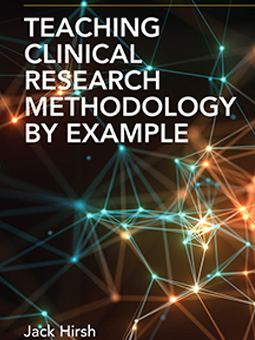
Teaching Clinical Research Methodology by Example has two principal objectives: (1) to tell the story of the research process in action and to provide a glimpse into the minds of the researchers responsible for some of the major advances (and setbacks) in modern medicine; (2) to explain the principles of evidence-based medicine by reviewing the research methods required to prove or disprove a theory.
This text is written in a style accessible to health professionals who do not have a background in clinical epidemiology.
The first section of the book, Causation, begins with an explanation of “casual” and “coincidental” associations and follows with examples:
- Smoking and lung cancer
- Dietary fats and coronary heart disease
- Cause and cure of peptic ulcers,
- Viral infection and cancer of the cervix
- Vaccination and autism
- Venous obstruction as the cause of multiple sclerosis.
The second section of the book explores prevention, treatment, and the ethical principles of clinical trials.
- Treatments presented include surgery for breast cancer, acute lymphoblastic leukemia, use of Viagra, stem cells in breast cancer, and the use of aspirin to treat heart attacks.
- Preventive measures discussed include vaccines, peri-menopausal hormone therapy, aspirin in the treatment of heart attacks, prevention of sudden death after heart attacks, stroke prevention, preventing fatal pulmonary embolism in surgical patients.
- Includes a chapter on assessing net clinical benefits of a treatment.
- Closes with a glossary of methodological terms.



